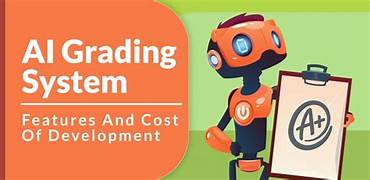AI in Automated Grading and Feedback Systems
The integration of artificial intelligence (AI) into education is revolutionizing how instructors assess student performance and provide feedback. Among the many applications of AI, automated grading and feedback systems have garnered significant attention for their potential to reduce workload, enhance consistency, and offer personalized learning experiences. These systems use machine learning algorithms, natural language processing (NLP), and other AI technologies to evaluate assignments, quizzes, and essays, often in real time. While the benefits are promising, the implementation of AI in grading also raises important questions about accuracy, fairness, and the role of educators in the learning process.
The Mechanics of AI-Powered Grading Systems
Automated grading systems operate by analyzing patterns, keywords, and structures in student submissions. Depending on the task, these systems can use different methodologies:
- Objective Assessments:
- For multiple-choice questions or numeric problems, AI relies on pre-defined answer keys to evaluate correctness. This is the simplest form of automated grading.
- Natural Language Processing (NLP):
- In essay grading, NLP models analyze text for grammar, syntax, coherence, and relevance to the prompt. Advanced systems can assess argumentative structure and creativity.
- Machine Learning Models:
- By training on datasets of previously graded work, these models can learn to predict grades based on historical trends and grading patterns.
- Adaptive Learning Feedback:
- Some systems go beyond grading by identifying areas of weakness and recommending resources or exercises to address specific gaps.
Advantages of AI in Grading
1. Efficiency and Scalability
Traditional grading methods are time-intensive, especially in large classes or standardized testing environments. AI systems can process hundreds of assignments in minutes, freeing educators to focus on more nuanced aspects of teaching. This scalability makes it particularly valuable in online education platforms and massive open online courses (MOOCs).
2. Consistency and Objectivity
Human grading is prone to variability due to fatigue, mood, or implicit bias. AI systems apply uniform criteria, ensuring consistent evaluation across all submissions. This objectivity is particularly important in high-stakes testing environments.
3. Immediate Feedback
AI systems can deliver real-time feedback to students, allowing them to learn from their mistakes without waiting for instructor review. Immediate feedback fosters a continuous learning cycle, where students can correct errors and apply new knowledge more effectively.
4. Personalization
AI can tailor feedback to individual students, addressing their unique strengths and weaknesses. For example, an essay grading system might highlight recurring grammatical errors for one student while suggesting improvements in argumentative clarity for another.
5. Reduction of Educator Workload
By automating routine grading tasks, AI systems allow educators to allocate more time to lesson planning, one-on-one student interactions, and professional development.
Challenges and Limitations
1. Accuracy and Fairness
Despite advancements, AI grading systems are not infallible. Errors in evaluation can stem from:
- Poorly designed algorithms.
- Insufficient training data.
- Misinterpretation of creative or unconventional responses.
Bias in AI models is another concern. If the training data reflects systemic biases, the system may perpetuate them, disadvantaging certain groups of students.
2. Overemphasis on Quantifiable Metrics
AI systems excel at evaluating objective criteria like grammar or factual accuracy but struggle with subjective elements such as creativity, emotional resonance, or cultural context. Overreliance on AI could lead to an education system that undervalues critical thinking and originality.
3. Privacy Concerns
The data required to train and operate AI systems often includes sensitive student information. Ensuring the privacy and security of this data is paramount to maintaining trust in these systems.
4. Dependency on Technology
Overdependence on AI grading tools could diminish educators’ ability to assess and provide feedback independently. This raises questions about the balance between human judgment and machine efficiency.
5. Student Perception and Acceptance
Students may question the fairness of AI-generated grades, particularly if they perceive the system as impersonal or overly rigid. Transparent communication about how the system works and its limitations is essential for building trust.
Use Cases in Automated Grading
- K-12 Education:
- AI tools are increasingly used to grade essays, quizzes, and assignments, helping teachers manage large workloads while providing individualized feedback.
- Higher Education:
- Universities leverage AI for grading large-scale assessments, particularly in introductory courses with high enrollment. Systems like Gradescope use machine learning to streamline grading workflows.
- Standardized Testing:
- Organizations like ETS and Pearson use AI to grade portions of standardized exams, including essay components.
- Language Learning:
- Tools like Grammarly and Duolingo incorporate AI to evaluate grammar, syntax, and language proficiency in real time, offering corrective feedback.
Ethical Considerations
1. Transparency
Educators and students must understand how AI systems operate, including their decision-making processes and limitations. Clear documentation and explainable AI (XAI) are critical.
2. Bias Mitigation
Developers must actively work to identify and eliminate biases in training datasets. Regular audits and diverse data inputs can help achieve this goal.
3. Human Oversight
AI should complement, not replace, human judgment. Educators should retain the final authority in grading, especially for subjective or ambiguous cases.
4. Accessibility
AI grading systems must be designed to accommodate students with disabilities, ensuring equitable evaluation for all learners.
The Future of AI in Grading
As AI technologies evolve, their role in grading and feedback systems will likely expand. Emerging trends include:
- Adaptive Learning Platforms:
- AI-driven platforms will integrate grading with personalized learning pathways, creating a seamless loop of assessment and instruction.
- Gamification of Feedback:
- Future systems may incorporate gamified elements to make feedback more engaging and motivating for students.
- Integration with Broader AI Ecosystems:
- Grading systems will increasingly integrate with AI-driven tools for curriculum design, student performance tracking, and career guidance.
- Ethical AI Frameworks:
- The development of standardized ethical guidelines will ensure that AI tools are deployed responsibly and inclusively.
Conclusion
AI-powered automated grading and feedback systems hold immense potential to transform education by enhancing efficiency, consistency, and personalization. However, their successful implementation requires careful consideration of ethical, technical, and pedagogical factors. By addressing these challenges and fostering collaboration between educators, developers, and policymakers, we can create systems that enrich learning experiences while preserving the essential human elements of education.


